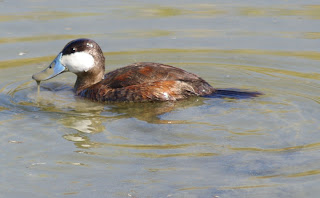 On the way to the refuge and on the way back, we often see a lot of other birds -- I was able to add three new birds to the life list -- I even have pictures! (Some are not so good). One bird we saw a lot of and that is new to our list is the Dunlin -- they seemed to be everywhere. I got this great pic of one flying.
On the way to the refuge and on the way back, we often see a lot of other birds -- I was able to add three new birds to the life list -- I even have pictures! (Some are not so good). One bird we saw a lot of and that is new to our list is the Dunlin -- they seemed to be everywhere. I got this great pic of one flying. We also saw Royal Terns (as opposed to Caspians). The main difference is that the bill is more orange than red. This is another new addition to the life list. I love their "hair do's" -- reminds me of Groucho Marx.
We also saw Royal Terns (as opposed to Caspians). The main difference is that the bill is more orange than red. This is another new addition to the life list. I love their "hair do's" -- reminds me of Groucho Marx. And the last "new" bird is the horned lark. These were at a bit of a distance from the boat and they were running across an open stretch of land, so the pic is not so good -- but it works for documentation. ;-)
And the last "new" bird is the horned lark. These were at a bit of a distance from the boat and they were running across an open stretch of land, so the pic is not so good -- but it works for documentation. ;-) Captain Tommy is a great birder, with a great sense of humor. He makes a point to identify all sorts of birds along the way -- not just the whoopers. For example, he reminded us that the American Oyster Catcher is misnamed. It's not like it's all that hard to "catch" oysters.
Captain Tommy is a great birder, with a great sense of humor. He makes a point to identify all sorts of birds along the way -- not just the whoopers. For example, he reminded us that the American Oyster Catcher is misnamed. It's not like it's all that hard to "catch" oysters. Kingfishers are common around water -- though I'm more used to seeing them inland. They have such a prominent crest shape that they are easily identified on a post or wire, but not necessarily when flying. Fortunately, I saw this one on a post first.
Kingfishers are common around water -- though I'm more used to seeing them inland. They have such a prominent crest shape that they are easily identified on a post or wire, but not necessarily when flying. Fortunately, I saw this one on a post first. Something new that I learned from our esteemed guide. There are two kinds of cormorants in our area: Double Crested and Neotropic. The differences according to Sibley's are mostly a little white at the corner of the eye. I wasn't particularly sure how to tell them apart. Captain Tommy pointed out that the Neotropics are darker and smaller. There are both in this picture.
Something new that I learned from our esteemed guide. There are two kinds of cormorants in our area: Double Crested and Neotropic. The differences according to Sibley's are mostly a little white at the corner of the eye. I wasn't particularly sure how to tell them apart. Captain Tommy pointed out that the Neotropics are darker and smaller. There are both in this picture. If you've viewed this blog in the past, you'll know that I'm especially fond of birds of prey. Most of the "hawks" that I saw were at a pretty good distance. At first I thought this bird was a hawk of some sort (seen from a distance without optics), but it turns out it's a Black Crowned Night Heron. I've seen one before, but this is my first chance at a photo.
If you've viewed this blog in the past, you'll know that I'm especially fond of birds of prey. Most of the "hawks" that I saw were at a pretty good distance. At first I thought this bird was a hawk of some sort (seen from a distance without optics), but it turns out it's a Black Crowned Night Heron. I've seen one before, but this is my first chance at a photo. Usually, we see a lot of Ospreys in the area. We saw a few, but most were far away, flying or the boat was moving. This was my best osprey shot of the day.
Usually, we see a lot of Ospreys in the area. We saw a few, but most were far away, flying or the boat was moving. This was my best osprey shot of the day. But my best sighting of the day -- even better than the flying whoopers (IMO) was this Peregrine Falcon. This one was on a nesting platform, so I'm hoping she has a nest there -- but maybe it's just a lunch stop.
But my best sighting of the day -- even better than the flying whoopers (IMO) was this Peregrine Falcon. This one was on a nesting platform, so I'm hoping she has a nest there -- but maybe it's just a lunch stop.
Okay, I saved the best till last. We saw about three sets of whoopers this time around. One set was a family. The bird with the brown splotches is the juvenile.
And finally, we saw a pair of whoopers, who also flew. Here they are, below.
























